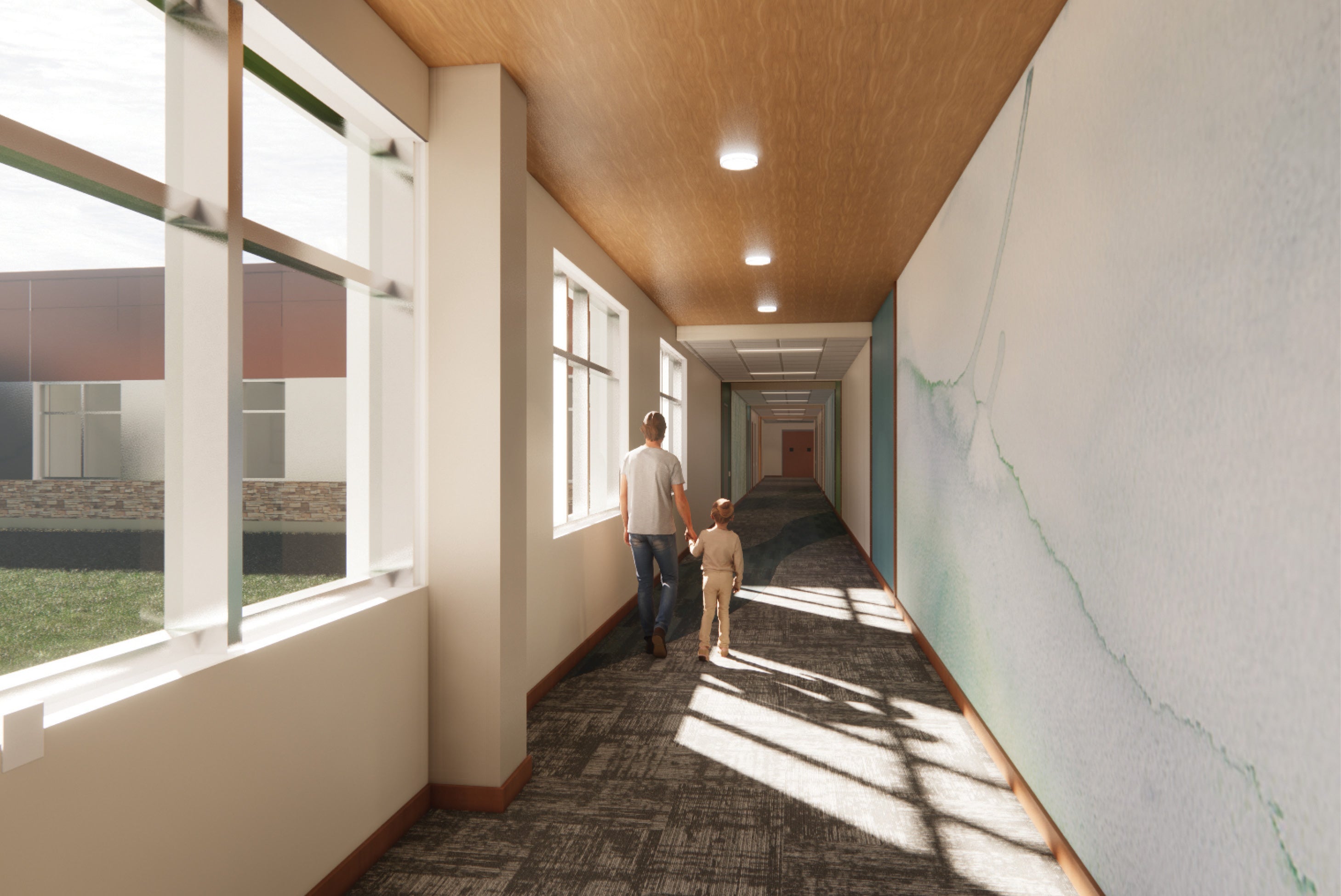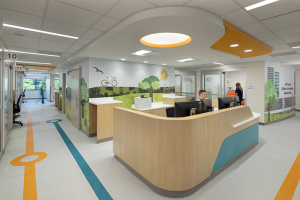Pediatric behavioral health facilities emphasize good design

The design of PrairieCare’s new facility emphasizes soft, soothing colors and natural light to create a serene space for its patients and their families.
Rendering from Pope Design Group
Last fall, three leading professional societies declared a “national emergency” in children’s mental health, citing the toll of the COVID-19 pandemic on physical isolation, uncertainty, grief and fear. This impact came on top of pre-existing mental health challenges confronting children and adolescents, reflected in a decade of steadily rising suicide rates.
Among their recommended actions, the American Academy of Pediatrics, American Academy of Child and Adolescent Psychiatrists and Children’s Hospital Association urged policymakers to increase federal funding for mental health services and address ongoing challenges in the acute care needs of children and adolescents.
A number of pediatric facilities across the country are demonstrating their commitment to meet this national need through new construction or renovations.
PrairieCare, a specialized psychiatric services provider in the Twin Cities, is adding 30 inpatient beds to the existing 71 psychiatric beds at its youth psychiatric hospital in Brooklyn Park, Minn. Erica Larson, AIA, CID, CHID, EDAC, LEED AP BD+C, vice president and principal for the Pope Design Group, lead planner for the PrairieCare expansion, says that supporting patient care through design principles starts at the unit’s front door.
“The first thing you will see when you enter the lobby is the reception desk straight ahead, while the security office is strategically placed behind you,” she says. “Security staff have full view of you, but you don’t see them when you first enter.”
Because many admitted children are coming to the facility by ambulance from a hospital emergency room, appropriate lighting and colors at the entrance can set the tone for the child’s entire visit, adds Liz Jaunich, PrairieCare’s director of real estate and facilities management.
“The first impression needs to be one of warmth and compassion,” Jaunich says.
The design team set out to create a space that’s safe — keeping patients from self-harm or harming others — while avoiding the white walls or concrete blocks of a stereotypical psychiatric hospital. For instance, metal detectors are part of the entrance, but they are built into the walls, so it seems like walking through a doorway. The facility also pays great attention to the use of color.
“We have a 28-color paint palette, and we use colors you find in nature, which feel soft and soothing,” Larson says.
Striking a balance between a healing, homelike atmosphere and the need for safety, durability and maintenance weighed against cost requires an open mind, she says.
Another pediatric facility on the horizon is the new, 47,000-square-foot Center for Advanced Behavioral Healthcare at Children’s Hospital of Philadelphia (CHOP) located at 4601 Market Street in West Philadelphia. The center will offer increased access to pediatric behavioral health care and includes office consultation rooms, group therapy rooms and five calming quiet rooms, emphasizing soothing, comfortable furniture and sensory details.
“The collective goal was to create a welcoming, positive, uplifting, healing environment that patients and families are happy to visit,” says Jacqueline Simmers, facilities planner III in facilities planning and design at CHOP.
Full-scale, on-site mockups helped the team envision the patient and staff experience, as well as allow modifications of the design based upon feedback.
At Dayton (Ohio) Children’s Hospital, the design and construction team is also preparing to break ground on a freestanding mental health building that will double its inpatient psychiatric beds from 24 to 48.
For the current and planned psychiatric units at Dayton Children’s Hospital, each patient’s room will have an interactive board on the wall that functions as a giant computer tablet. Patients can use this technology to assert control over their environment, controlling the color, writing or drawing pictures on it, and having FaceTime sessions with their families, says Cindy Burger, R.N., the hospital’s vice president and chief experience officer.
Dayton Children’s also works with an art consultant with expertise in pediatrics who recommends art that clinicians review and approve, Burger says.
“To put nothing on the walls is not an option for us,” Burger says “No one wants to look at plain white walls.”
The space also emphasizes the role of nature on patient experience. Natural light and access to fresh air are paramount. Also, indoor lighting reflects day/night cycles so as not to interrupt patients’ circadian rhythms.
“We want dignity and comfort and some whimsy, but safety is the number one goal,” Burger explains. “I believe human behavior can be influenced by the environment.”




